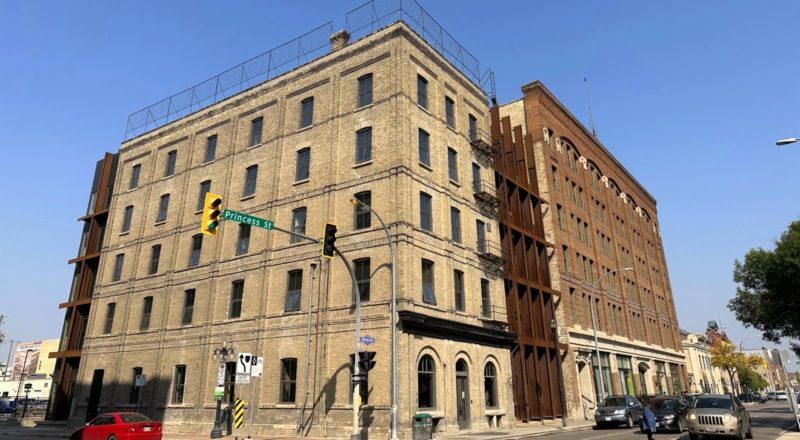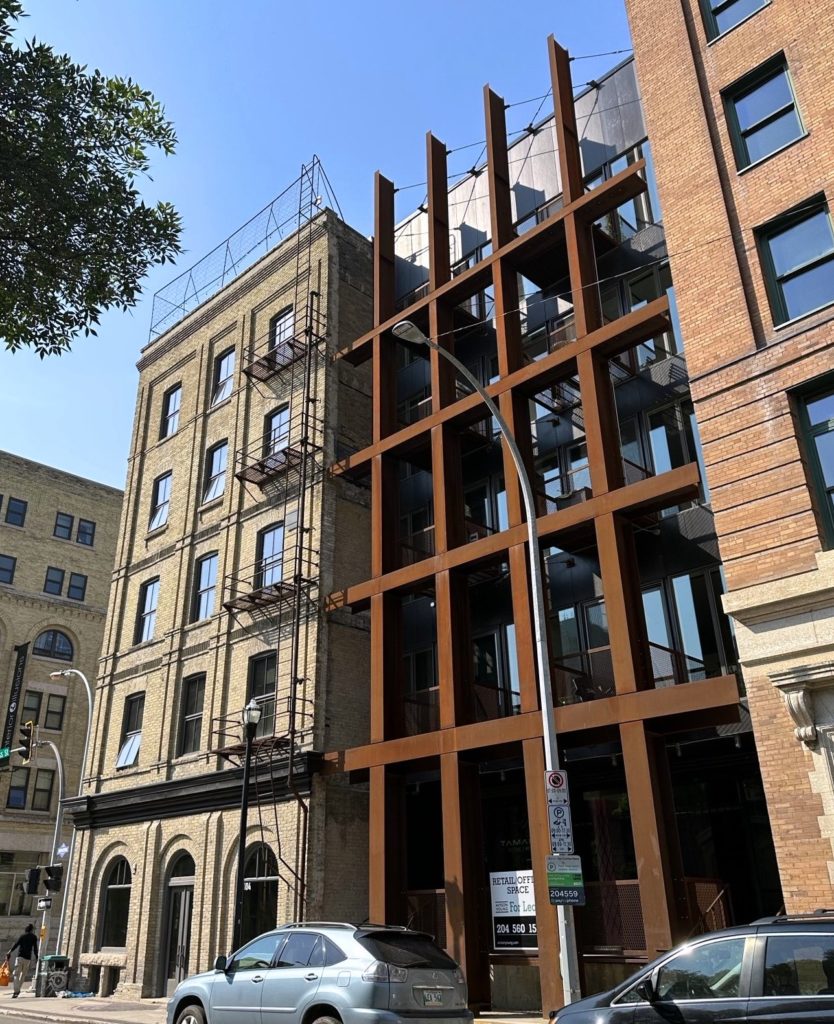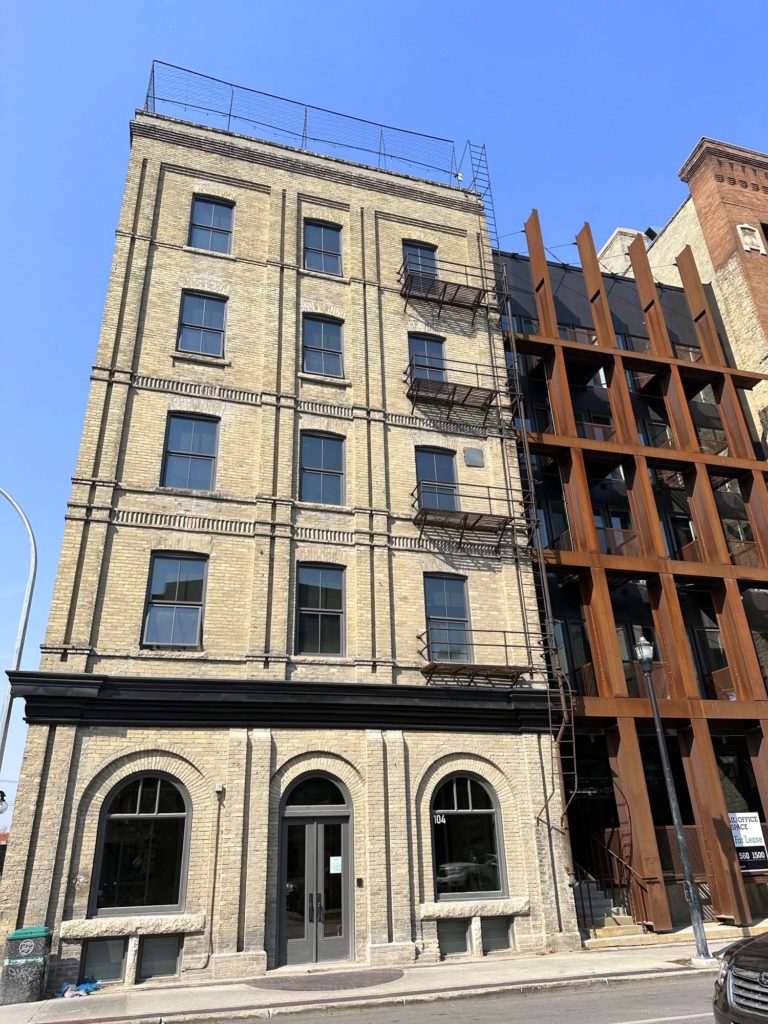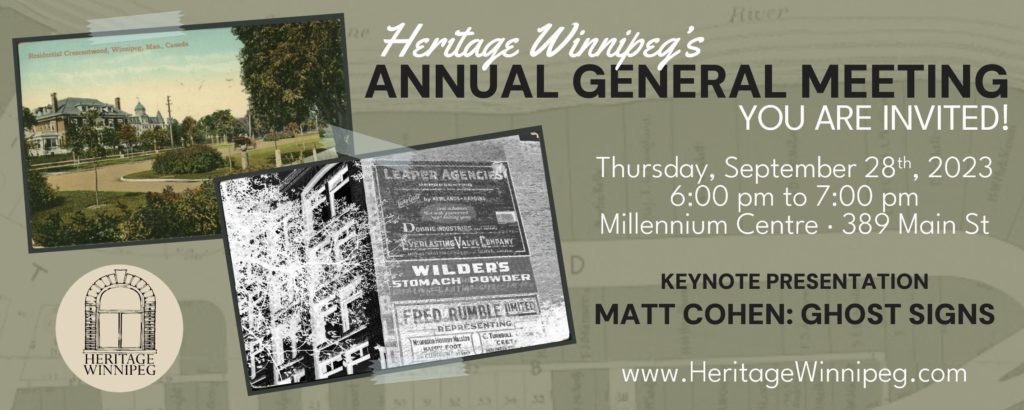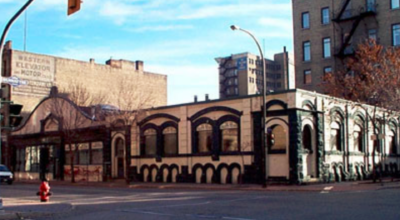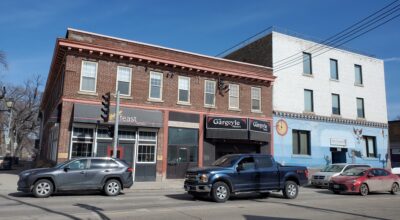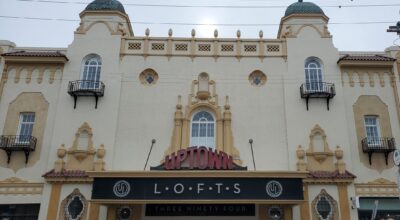
/ Blog
September 22, 2023
Hardened By Fire: 104 & 108 Princess Street
At the corner of Princess Street and Bannatyne Avenue sits two buildings with an intriguing history… or is it one building? From the back, they now appear to be one modern building, but from the front, one half is from the 19th century while the other half is very much from the 21st century. Standing side by side, the buildings at 104 & 108 Princess Street share a foundation but a tragedy caused their life stories to wildly diverge. Today they are rejoined and rejuvenated, serving their community and setting the bar high for what a historically sensitive infill project should look like.
Built as a speculative venture in 1885, 104 and 108 Princess Street were once two sections of the same warehouse, identical twins separated only by a party wall. A building with an air of mystique, there is no record of the architect that designed it and no formal building name to be recorded in the annals of history. The project had belonged to the Confederation Life Association, but the building was never christened with the company’s name. Instead, it is only remembered by its street address.
When constructed, the building had a stone foundation supporting a solid three storey brick building. Today, the first three storeys of 104 Princess look very much as they did nearly 140 years ago, with only the ground floor of the front facade having been greatly altered. Initially, the front entrance to the building was recessed and set between large plate glass windows that ran the length of the ground level of the facade. As the surrounding streets were not paved or levelled at the time of its construction, more of the building’s foundation was originally exposed, with the loading dock at the back rising almost two feet higher off the ground than it did in later centuries.
Hodgson, Sumner and Company, an importer and distributor of dry goods, was the first business to occupy 104 Princess Street while Sutherland and Campbell, a wholesale grocery firm, was the first to move into 108 Princess Street. The company’s names were advertised boldly on signs that ran across the building’s parapet wall, with gothic pilaster caps rising above. This parapet wall no longer exists, because in 1904 it was removed to accommodate two additional storeys, designed by Architect Daniel Smith. The window pattern of the new floors remained the same, although less brick details accompanied them and the final decoration along the roofline was simplified. It was during this phase of construction that the front facade of the ground floor received a makeover, with the flush entrance and round brick arches we still see today at 104 Princess Street. The work was completed in 1905, and it is suspected that the original metal cornice running between the first and second floors survived this facelift, only to disappear in later years. The Consolidated Stationery Company Limited then moved into the building, taking over all five floors of both 104 and 108 Princess Street.
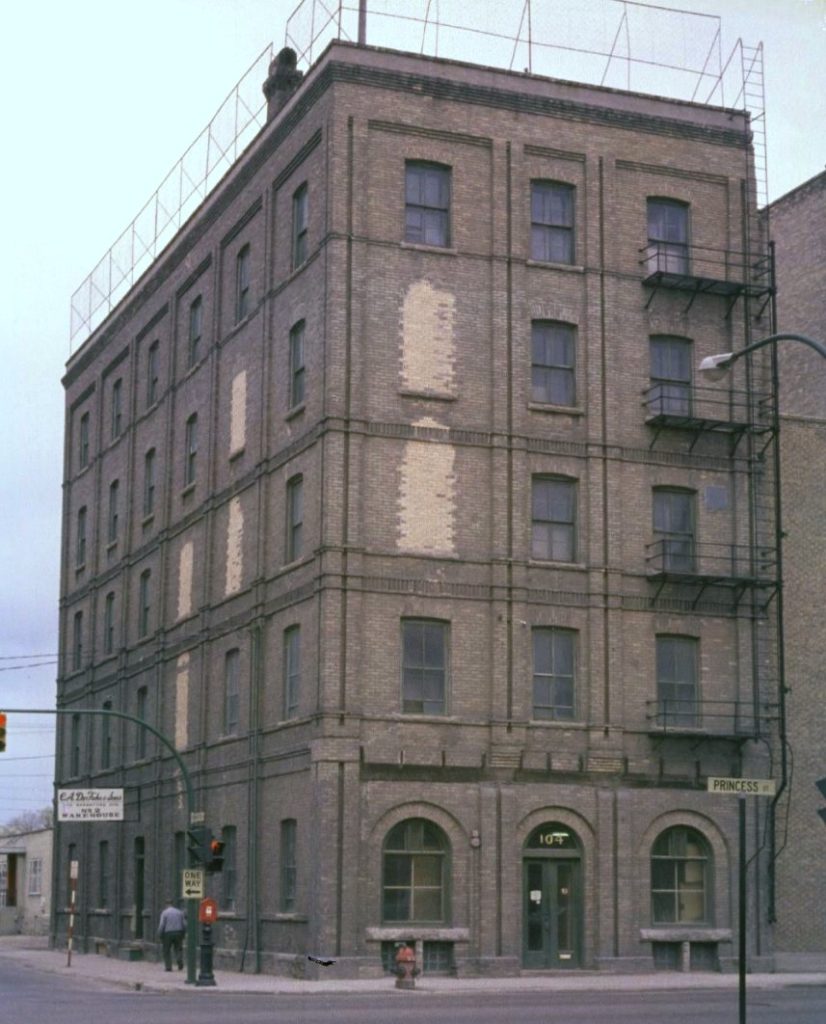
A photo of 104 Princess Street in 1976.
Source: Winnipeg Building Index (University of Manitoba Libraries)
Over the years, various businesses would come and go from the twin buildings, with alterations being made to accommodate them. The building even stood vacant for a time. But it was not until 1945 that a particularly newsworthy event took place at the buildings. That year, on March 23rd around 10:50 pm, a fire started at 108 Princess Street. The building was being used by Robinson and Weber, a wholesaler and re-packager of chemicals. Their chemicals exploded, with alcohol, turpentine and bags of sawdust, further fueling the flames. It was a three alarm fire with 80 firefighters battling over twelve hours, during which tragedy struck.
With the intense heat and the eventual collapse of 108 Princess Street, two firefighters, Frank Sandison and James Smith, lost their lives while four more were seriously injured. The blaze was so extreme that fires continued to break out for the next two days after the original fire had been doused. Despite this horrible loss of life and destruction of a building, the firefighters succeeded in saving 104 Princess Street and Sterling Cloak Building at 110 Princess Street, which also abutted 108 Princess Street. An investigation into the terrible fire resulted in no satisfactory conclusions. The cause of the fire remained undetermined, and no one could agree if the upper floors had been overloaded, causing the calamitous cave in during the blaze.
Demolished nearly down to the foundation, 108 Princess Street would remain levelled – like a broken tooth in the historic streetscape – until 1950 when a three storey brick building rose from the same stones. This building was constructed with steel reinforcements, perhaps an effort to prevent a repeat of the 1945 tragedy? Still connected to 104 Princess Street by way of fire doors, the new building could not have been more plain. Aside from the simplest rectangular windows and a door, there was not a single piece of ornamentation on the facade, making it look like a cheap and poorly designed infill project sandwiched between the historic 104 Princess Street and the stately 1907 Sterling Cloak Building. The only hint of 108 Princess Street’s past was found at the back of the building, where some of the original wall still stood on the ground floor and was incorporated into the new 1950 building.
In 1984, 104 Princess Street was added to the City of Winnipeg’s List of Historical Resources, protecting it from alteration of this character defining element and demolition of the entire building. But it would soon face a new threat – instead of intense heat, this time it was the intense cold. The building had been heated with steam from the Amy Street Steam Heating Plant. The 1924 plant was a poorly maintained, heavy polluter that was deemed too costly to continue operating, closing in June of 1990. Its closure resulted in 4.3 million square feet of buildings being left out in the cold, with many building owners struggling to find the money to install a new heating system in their structures. The closure of the Amy Street Steam Heating Plant had a particularly negative impact on the Exchange District, where buildings like 104 Princess Street were left vacant and decaying without the steam heat.
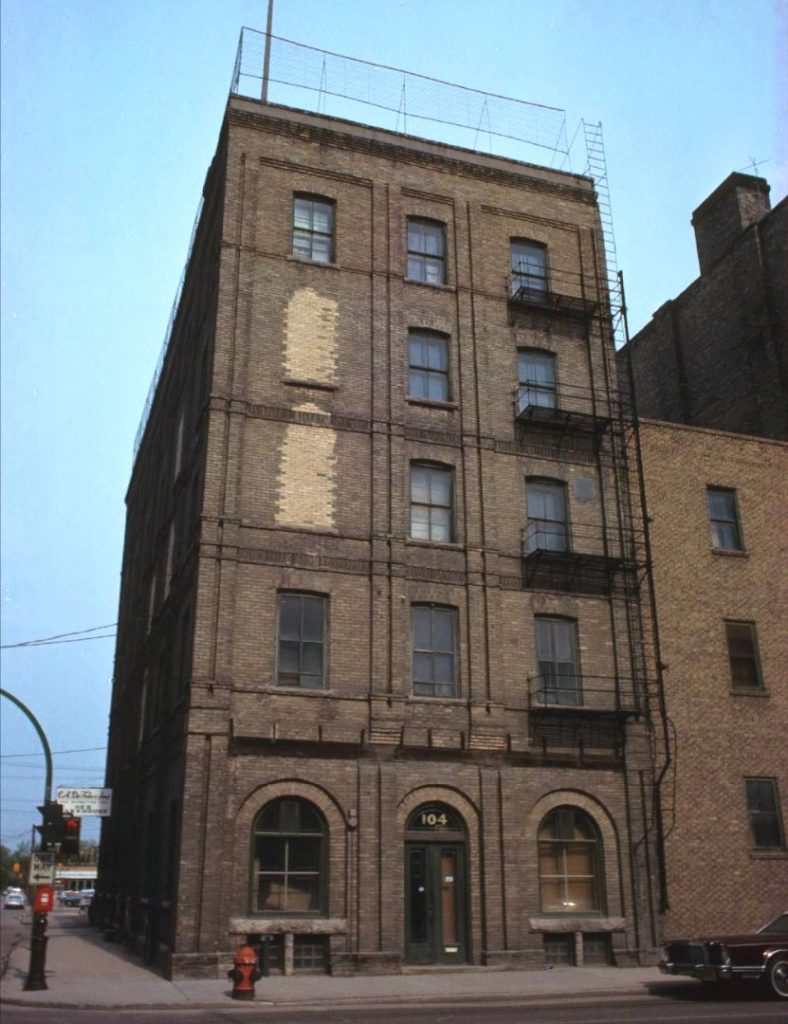
An undated photo of 104 Princess Street, with part of the 1950 version of 108 Princess Street visible on the right.
Source: Winnipeg Building Index (University of Manitoba Libraries)
This was not the end of trouble for 104 Princess Street. The resilient building faced adversity once again in 2004, when an application was made to demolish the building. Fortunately, the city respected the protection afforded by the building’s historical designation, and rejected the application.
After standing tall for 133 years, in 2018 things were looking up for 104 Princess Street once again. A redevelopment project was started with the intention to conserve and upgrade the building, converting it into commercial space in the basement and ground floor, with residential units above. This project is representative of a growing trend in the East Exchange District, converting old warehouses into residential spaces, similar to what has happened in the West Exchange District. As part of this project, the metal cornice that was once above the ground floor was replaced, returning a touch of elegance to the facade. Finished, it is a testament to the resilience of historical buildings, tested by fire and ice, time and neglect, but still ready and able to serve the community when given the chance.
With the redevelopment project, 104 Princess Street’s other half, 108 Princess Street, was not forgotten. It was part of the same redevelopment project, also adaptively reused as a mixed use building. A two storey addition provided more space for residential units and more cohesive streetscape. An addition was also added across the back of 104 and 108 Princess Street, creating a definitive connection between the two buildings once again.
Fortunately, the developers also saw fit to change the horribly austere facade of 108 Princess Street, pushing the front of the building back about 10 feet to make space for a ground level patio and balconies above. In place of the original facade, a four by four vertical grid of Corten steel beams was installed. Also known as weathered steel, this material is a resilient steel alloy used for outdoor construction that quickly develops a rusted appearance when left unpainted. The grid pattern compliments the facade of 104 Princess Street in a pleasing manner, extending the ornamental pattern in the facade’s brick courses while echoing the regularity in the pattern of the windows. At the same time, the rust colour of the steel coordinates with the red brick facade of the Sterling Cloak Building on its other side. Intentional or not, the bright orange rust colour also pays homage to the fire that destroyed the original 1885 building. When viewed in the context of the historic streetscape, the new appearance of 108 Princess Street fits in well without pretending to be a 19th or 20th century building. The steel grid is also used on the new addition on the back of the building, providing continuity through the entirety of the two structures.
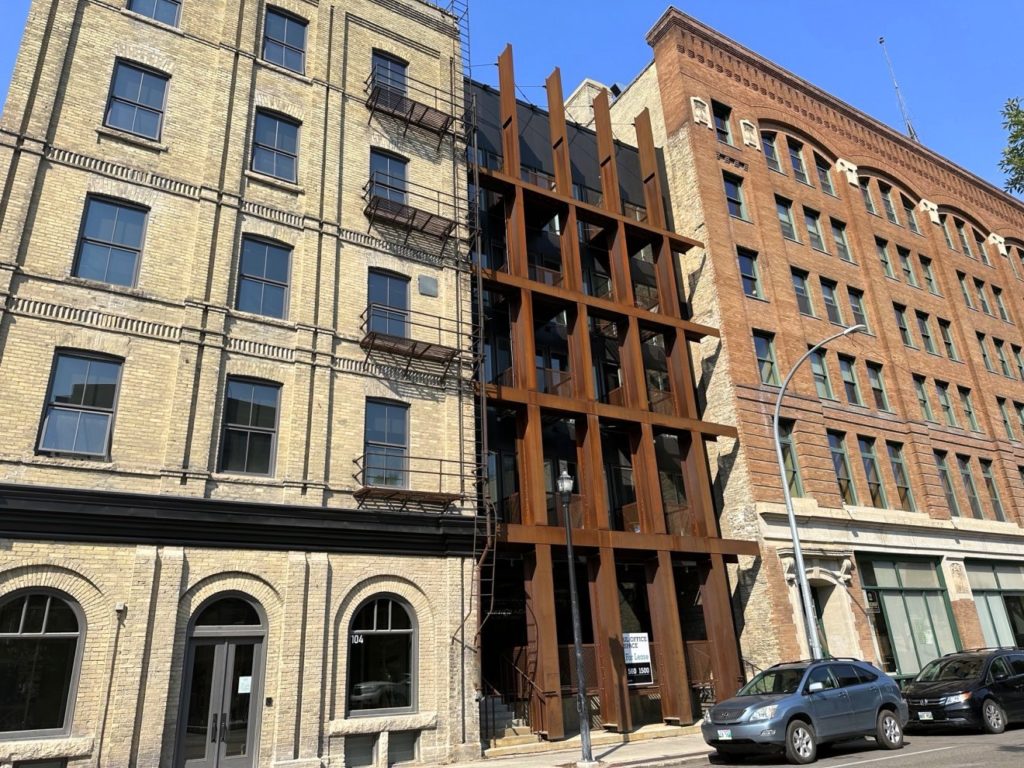
104 Princess Street, 108 Princess Street and 110 Princess Street (Sterling Cloak Building) in September 2023.
Source: Heritage Winnipeg
With the redevelopment completed, 104 and 108 Princess Street were renamed “Warehouse 1885” with nearly 40 units available for rent. It is a great example of both adaptive reuse and gentle densification, making the best use of existing buildings and spaces to better serve the community without disregarding the current character or residents. But not all developers are this sensitive to a building’s history, context and community, focused only on their bottom line. The result of this attitude are projects like the 1950 version of 108 Princess Street, detracting from the community instead of adding to it. This is why good design guidelines for redevelopment and infill projects in the Exchange District are crucial in maintaining the integrity and vibrancy of this national historic site. Heritage Winnipeg is hopeful that the City of Winnipeg will see the Warehouse 1885 project as a bright light, guiding their new legislation for future infill projects. When done correctly in an historically sensitive manner, new projects in old neighbourhoods can blaze a trail to vibrant, sustainable communities that we would all be proud to call home!
THANK YOU TO THE SPONSOR OF THIS BLOG POST:

Written by Heritage Winnipeg.
SOURCES:
104-108 PRINCESS STREET WAREHOUSE | Historical Buildings Committee - February 22, 1983
104-108 Princess Street - Warehouse | Winnipeg Building Index - University of Manitoba Libraries
1984: The Year Past | Report of the City of Winnipeg Historical Buildings Committee
Fairchild Building | Winnipeg Architecture Foundation
Tunneling Into History: The Amy Street Steam Heating Plant | Heritage Winnipeg - December 22, 2022
Warehouse 1885 | Wpg_Guy - skyscraperpage.com - October 21, 2019
What Is Corten Steel? | Corten.com
The Year Past 2020 | City of Winnipeg Historical Buildings & Resources Committee





